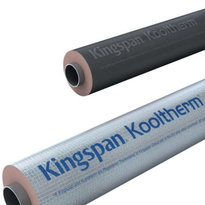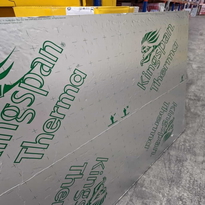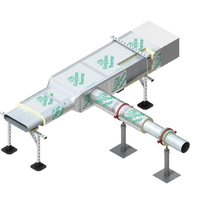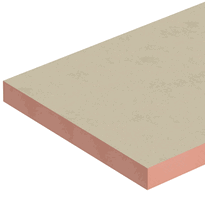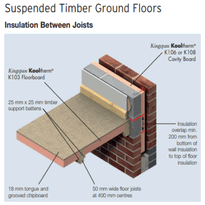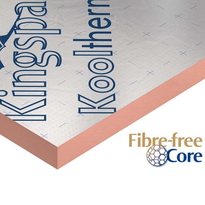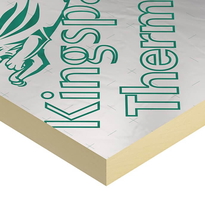Kingspan Insulation Board
Kingspan insulation boards are high-performance materials designed to enhance building energy efficiency, durability, and moisture resistance. They are available in a variety of types, including the Kooltherm range, renowned for its low thermal conductivity, and GreenGuard XPS boards, which offer exceptional water resistance and load-bearing strength. These versatile solutions cater to a range of applications, including roofing, walls, and floors.
The insulation boards are user-friendly, easily handled, cut, and fixed with best practices that support sustainable construction methods. To learn more about their specific features and applications, we encourage you to delve deeper into the information available.
Overview of Kingspan Insulation Board Types
Kingspan offers a comprehensive range of insulation boards tailored to meet various building requirements and performance standards.
The Kooltherm range features fibre-free, rigid thermoset phenolic core boards that are exceptionally thin yet highly effective. These boards are primarily used for walls, roofs, and floors, making them particularly suitable for narrow spaces.
The Therma range includes versatile boards designed for different parts of the building envelope, striking a balance between cost and performance for energy efficiency.
GreenGuard® XPS boards provide outstanding water resistance and high compressive strength, making them ideal for below-slab and foundation applications. These boards have a minimum compressive strength of 25 psi.
Additionally, specialised products such as KoolDuct, TEK panels, and vacuum panels cater to specific needs, offering tailored solutions for construction projects that require premium insulation performance.
With these diverse options, Kingspan ensures that builders and developers in the UK can find the right insulation solutions to enhance energy efficiency and meet regulatory requirements.
Thermal Performance and R-Values of Kingspan Boards
The thermal performance of insulation boards is crucial for their effectiveness and energy-saving potential. Kingspan boards are designed with low thermal conductivity values, which means they transfer less heat and provide superior insulation. For instance, the Kingspan Kooltherm K107 phenolic board stands out with its impressive thermal conductivity, the lowest among rigid boards, while the Kingspan Thermawall TW55 PIR also offers excellent thermal performance. Thicker boards typically have higher R-values, enhancing their ability to resist heat flow. Many Kingspan insulation products feature foil facings, which further improve thermal performance by minimising radiant heat transfer. The low thermal conductivity of Kingspan boards ensures minimal heat transfer, making them highly efficient for various building applications.
Mechanical Properties and Durability Features
Kingspan insulation boards are engineered with robust mechanical properties that allow them to support moderate loads while resisting damage during installation. Their impressive compressive strength and excellent water resistance contribute to long-term durability, even in damp or challenging conditions. They are designed to meet ASTM C 578 Type VI requirements, ensuring consistent quality and performance. These features make the boards a dependable choice for both structural and insulation applications across a wide range of building projects.
Designed for the UK market, Kingspan insulation boards offer reliable performance, ensuring that they meet the demands of various environments while maintaining their integrity. With a focus on sustainability and efficiency, these boards provide an effective solution for enhancing thermal performance in buildings.
Compressive Strength Details
Compressive strength is an essential consideration when selecting insulation boards for construction projects, as it indicates the material's ability to support structural loads without deformation. Kingspan offers a variety of boards with differing strengths to cater to specific requirements. For instance, the GreenGuard GG40-LG is designed for heavy-duty applications, providing robust support for industrial floors. In contrast, the GG25-LG is suitable for use below slabs, offering adequate strength for foundations. The following table highlights some of the available options:
Product |
Compressive Strength |
Typical Use |
| Kingspan GG40-LG | High strength | Heavy-duty, industrial floors |
| Kingspan GG25-LG | Moderate strength | Foundations, below slabs |
| Kingspan Styrozone | High strength | Basements, car parks |
These ratings ensure durability and structural integrity across various building conditions, making it crucial to choose the right insulation board based on the compressive strength required for the project. Choosing the right product ensures optimal performance and longevity in demanding applications.
Resistance to Moisture
Moisture resistance is a crucial characteristic of Kingspan insulation boards, enabling them to endure exposure to water and high humidity environments. This feature renders them suitable for both above-grade and below-grade applications, where moisture can be a significant concern.
The closed-cell structure and composition of these boards, made from extruded polystyrene (XPS), enhance their moisture resistance, minimising the risk of water absorption that could undermine insulation performance. Even when faced with moisture, these boards retain their shape and insulating properties, contributing to long-term durability. Their low water absorption rate also ensures consistent thermal performance over time. Kingspan boards are versatile and can be employed in a variety of scenarios, bolstering building efficiency and safety.
Ideal for below-slab and foundation insulation, they effectively resist water intrusion.
Suitable for external walls and foundation applications that are exposed to moisture.
They maintain their insulating properties even after prolonged water exposure, ensuring reliable performance.
Common Applications and Uses in Construction
Insulation boards are highly versatile materials widely utilised in construction projects across the UK. Kingspan boards, for instance, are an excellent choice for roofing applications, delivering outstanding thermal performance for flat roofs and suitable for both new builds and refurbishments.
These boards can be installed above or below damp-proof membranes, with high-strength variants designed for heavy-duty commercial roofs and inverted roof systems.
For below-ground applications, XPS boards, such as GreenGuard, are effective at resisting moisture and are compliant with standards for basement and foundation insulation. They provide robust support for foundation walls and slabs, managing heavy loads with ease.
In wall constructions, Kingspan boards enhance energy efficiency and moisture resistance, making them particularly beneficial in cavity and rainscreen systems.
Additionally, XPS insulation is an ideal solution for commercial floors, car parks, and plaza decks, owing to its durability and impressive load-bearing capabilities.
Installation Techniques and Handling Tips
Proper cutting and shaping of Kingspan insulation boards are vital for achieving accurate fits and ensuring effective performance. Utilising the correct saw blades and handling the boards with care is crucial to prevent any damage and ensure clean, precise cuts.
Moreover, adhering to best practices for jointing and fixing is essential to maintain airtightness and structural stability throughout the installation process. This attention to detail not only enhances the insulation's effectiveness but also contributes to the overall integrity of the building.
When working with insulation materials, always prioritise safety and follow manufacturer guidelines to achieve the best results. By doing so, you can ensure a successful installation that meets all performance standards.
Cutting and Shaping Tips
To achieve clean, precise cuts when working with Kingspan insulation boards, it's essential to select the appropriate tools and techniques. A fine-toothed saw is ideal for ensuring smooth edges without tearing the paper facer. Sharp utility knives, such as Stanley knives, are perfect for scoring and snapping boards, particularly those with thicknesses ranging from 15mm to 50mm.
Applying water can help minimise dust and static particles during cutting; however, it may create a mess, so be prepared for workspace cleanup. Additionally, spraying water on PIR boards reduces airborne particles by about 60%, making it a recommended dust-free cutting method to improve safety.
Utilise guide rails or straight timber edges for accurate, straight cuts
Score both faces before snapping to prevent cracking or ragged edges
Always handle the boards with care and measure twice to avoid waste
Following these guidelines will help you achieve a professional finish while ensuring safe and controlled cutting.
Jointing and Fixing Best Practices
Installing Kingspan insulation boards necessitates meticulous attention to jointing and fixing practices to ensure optimum performance over time. The boards should be lightly butted together to eliminate gaps; should any gaps occur, they can be sealed with low-expansion foam.
Utilising mechanical fixings, such as screws or galvanised nails, is essential to prevent sagging, particularly when the boards are positioned across rafters or close to masonry. For wall applications, screws must be placed at suitable intervals, ensuring they are at least 10 mm from the edges to avoid potential damage.
When sealing joints or seams, it is crucial to overlap the seams by at least 6 inches and securely apply 3-inch wide tape, pressing it down firmly with tools like J-rollers. Proper fixing techniques help to prevent cracks and maintain thermal continuity across the installation.
Using compression fits in conjunction with mechanical fixings further stabilises the boards, ensuring consistent insulation and long-lasting durability.
Fixing Technique |
Best Practice |
| Mechanical Fixings | Use screws or nails across framing, avoiding board edges by 10 mm |
| Sealing Gaps | Fill small gaps with foam or carefully butt boards |
| Joint Taping | Overlap seams by 6 inches, apply tape, press firmly |
| Additional Fixings | Pre-plan for service penetrations and internal fittings |
Environmental Certifications and Sustainability Aspects
Environmental certifications and sustainability features are essential in demonstrating the eco-friendliness of Kingspan Insulation Boards. These certifications reflect their dedication to transparency, resource efficiency, and minimising environmental impact.
For instance, Kingspan XPS Insulation Boards boast Environmental Product Declarations (EPDs) that comply with ISO standards. These declarations encompass life cycle assessments, examining everything from resource usage to waste impacts, and are verified by independent reviewers.
Moreover, Kingspan’s GreenGuard® XPS Boards are Energy Star certified, which underscores their energy efficiency and aids in reducing operational emissions. The company's BES 6001 certification showcases their commitment to responsible sourcing, ensuring sustainable practices throughout their supply chain.
In addition, Kingspan adheres to ISO 37301 standards at their North American facilities, reinforcing robust environmental and compliance management. These certifications instil trust and foster a sense of belonging among eco-conscious builders and clients who are committed to sustainability.
Comparing XPS and PIR Kingspan Insulation Boards
Kingspan Insulation Boards are available in two primary types: XPS and PIR, each presenting unique advantages tailored to specific applications.
PIR boards are renowned for their lower thermal conductivity, which allows for superior insulation performance even with thinner profiles. They're frequently equipped with foil facings that enhance vapour control and reflect radiant heat, making them particularly suitable for confined spaces such as pitched roofs and internal walls. PIR insulation typically has a thermal conductivity of 0.022 W/mK.
Conversely, XPS boards tend to be thicker yet maintain consistent thermal performance without the need for additional layers. This makes them an ideal choice for rigorous environments. XPS also boasts higher compressive strength, rendering it more suitable for areas subjected to heavy loads, such as basements or flooring. Furthermore, the closed-cell structure of XPS provides excellent moisture resistance, ensuring durability in damp conditions.
Both types of boards cater to distinct needs, making them essential selections based on the specific requirements of your project.
Benefits of Using Kingspan Insulation in Building Projects
The benefits of using Kingspan insulation in building projects are extensive and significant. Its exceptional thermal performance aids in reducing energy costs by minimising heat loss through walls and roofs. This not only lowers utility bills but also supports adherence to contemporary energy regulations while reducing the building’s carbon footprint. Superior thermal performance and energy efficiency Kingspan insulation is designed for durability and moisture resistance, safeguarding against mould, rot, and deterioration, even in demanding environments. The installation process is quick and flexible, thanks to lightweight materials and integrated panel systems, which enhance construction efficiency. Moreover, utilising Kingspan insulation aligns with sustainability objectives through energy savings, reduced embodied carbon, and the use of recyclable materials. Teams engaged in various projects recognise these benefits, knowing they're constructing with environmentally conscious, reliable, and high-performance insulation solutions that promote a sense of collective achievement.
Maintenance and Longevity of Kingspan Insulation Systems
Regular maintenance is essential to ensure the longevity and optimal performance of Kingspan insulation systems. Conducting routine inspections of roofs and exterior panels is vital in identifying issues such as coating degradation, debris accumulation, and fastener concerns at an early stage.
Cleaning panels and joints is crucial to prevent damage and maintain their overall integrity. Addressing coating defects promptly and replacing faulty fasteners or missing caps will extend the lifespan of the system and mitigate moisture risks.
Effective moisture management is also imperative; while Kingspan boards are designed to resist moisture, water ingress from leaks or condensation can undermine insulation performance. The correct installation of flashing and vapour barriers is necessary to prevent moisture penetration, while ensuring adequate ventilation helps to avoid mould growth and saturation.
Routine inspection and timely repairs will ensure that Kingspan systems continue to perform at their best, providing lasting energy efficiency and structural stability.
Conclusion
Kingspan insulation boards provide a dependable and efficient solution for enhancing energy performance in buildings. With a diverse range of types tailored for various applications, they deliver excellent thermal performance and durability.
These boards are straightforward to install and come with environmental certifications, making them suitable for a wide array of construction projects across the UK.
By using Kingspan insulation, you can improve the quality of your insulation, lower energy costs, and contribute to sustainability initiatives.
Overall, Kingspan insulation boards are a sensible choice for achieving effective and long-lasting building insulation, ensuring your project meets modern energy efficiency standards.

